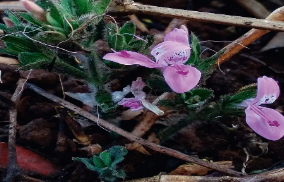Dicliptera polymorpha: New Fire-Resilient Plant Species Discovered
The Western Ghats of India is a biodiversity hotspot. Recently, scientists discovered a new plant species there. This species, named Dicliptera polymorpha, thrives in grasslands. It has a unique dual-blooming pattern triggered by grassland fires. This discovery contributes to the region’s rich biodiversity.
Discovery Team and Context
The discovery was made by a team from the Agharkar Research Institute (ARI) in Pune. Dr. Mandar Datar led the research, supported by botanist Adittya Dharap and Ph.D. student Bhushan Shigwan. The team collected the first specimens during the 2020 monsoon season. They monitored the species over the following years to confirm its unique traits.
Characteristics of Dicliptera polymorpha
Dicliptera polymorpha is notable for its fire-resilient nature. It blooms twice a year, with the first flowering phase occurring from November to April. The second phase happens in May and June, triggered by local grassland fires. This plant showcases an unusual inflorescence structure known as spicate inflorescences. It is the only Indian species with this structure, with closest relatives found in Africa.
Ecological Adaptations
This species has adapted to extreme climatic conditions. It survives summer droughts and frequent human-induced fires. During the second flowering phase, the plant produces dwarf flowering shoots from woody rootstocks. This adaptation allows for a more abundant, though shorter, flowering period.
The discovery of Dicliptera polymorpha raises important conservation concerns. Its unique adaptation to fire marks the need for careful management of grassland ecosystems. Frequent human-induced fires can support the species’ life cycle. However, unchecked fires could lead to habitat degradation.
Importance of Grassland Management
Effective fire management practices are essential. They must balance the needs of the species with the health of the ecosystem. Protecting grasslands from overuse is crucial for the survival of Dicliptera polymorpha. Ensuring biodiversity in the Western Ghats requires ongoing conservation efforts.
Research and Publication
The species’ novelty was confirmed by Dr. I. Darbyshire from Kew Botanic Garden. A research paper detailing the findings was published in the Kew Bulletin. This publication marks the significance of the discovery and encourages further exploration of the Western Ghats.
Future Research Directions
Continued research is vital to uncover more about this unique species. Further studies can reveal its ecological role and interactions within the grassland ecosystem. About its life cycle will aid in developing effective conservation strategies.
Important Facts for Exams:
- Agharkar Research Institute (ARI) – ARI is an autonomous research institute located in Pune. It focuses on biodiversity studies in the Western Ghats. It contributes to ecological research.
- Dicliptera polymorpha: This newly discovered species blooms twice a year. Its inflorescence structure is unique to India. It thrives in extreme conditions and is fire-resilient.
- Spicate Inflorescence: Spicate inflorescence is a rare floral structure. It features elongated flower clusters. Dicliptera polymorpha is the only Indian species exhibiting this structure.
- Western Ghats: The Western Ghats is a UNESCO World Heritage Site. It is one of the world’s eight “hottest hotspots” of biological diversity. It contains numerous endemic species and unique ecosystems.
Month: Current Affairs - November, 2024
Category: Environment Current Affairs


